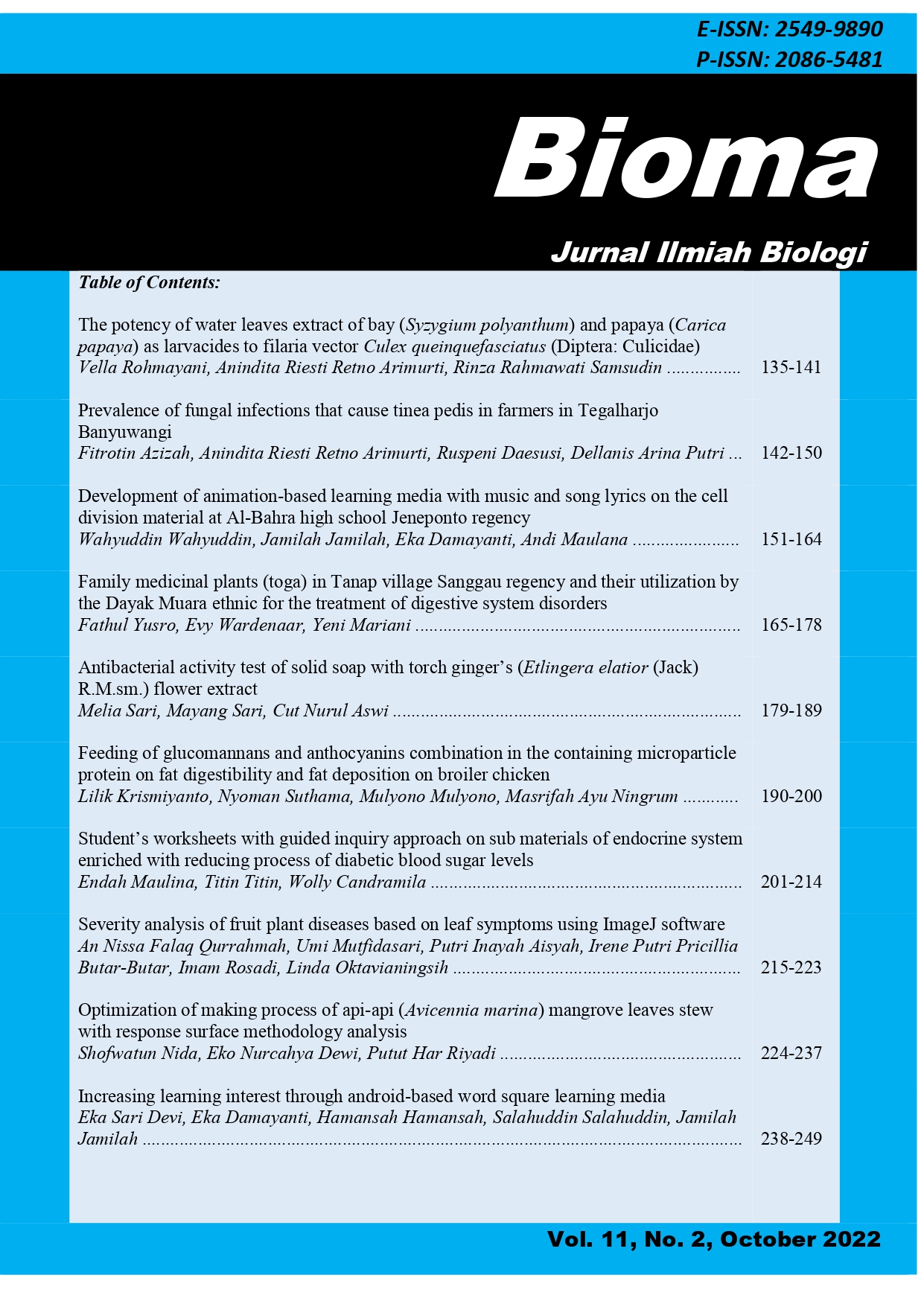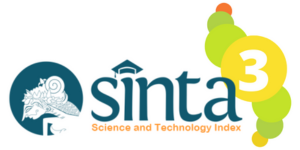ANATOMICAL STRUCTURE STUDY OF Solanum torvum Sw.
DOI:
https://doi.org/10.26877/bioma.v14i2.2685Keywords:
Histological observation; Internal structure; Plant anatomy; SolanaceaeAbstract
The Anatomy of Tekokak (Solanum torvum Sw.) is a plant that grows wild in the forest and its fruit is used as a vegetable. This study aims to complete the study of the anatomical structure of tekokak and identify typical microscopic characteristics that can be used as specific markers. This research is important in order to contribute to the scientific documentation of local plant taxonomy and support the utilization of plants in the fields of pharmacy, conservation, and as an a reference for botanical education in Biology. The research data were analyzed using a qualitative descriptive method by comparing the characteristics of the samples found with references. The results of this study include image data and qualitative descriptive data obtained from the anatomy of the roots, stems and leaves of Solanum torvum Sw The root of S. torvum Sw. consists of the epidermis, exodermis, a cortex layer made up of cortex parenchyma, endodermis with Casparian strips, a pericycle or pericambium layer, special medullary ray structures, and vascular tissues, xylem, and phloem. The stem part is composed of an epidermis with star-shaped non-glandular trichomes, lamellar collenchyma, cortex, endodermis layer, pericycle, vascular tissue comprising xylem and phloem, and pith. The anatomical difference between unbranched and branched stems lies in the arrangement of the vascular bundles, the thickness of the supportive tissue, and the complexity of the vascular tissue, indicating structural adaptations to the position and function of the stem. On the stem found scalariform trachea, annular trachea, reticulate trachea, thickened reticulate trachea, tracheid, fiber tracheid and libriform fiber. The leaf cross-section shows adaxial epidermis with cuboid-shaped cells and anisocytic stomata, palisade parenchyma, spongy parenchyma, abaxial epidermis with anomocytic stomata, and non-glandular star-shaped trichomes.
References
Ainiah, N., Rahayu, T., & Hayati, A. (2020). Analisis Karakter Fenotip Beberapa Spesies Dendrobium [Analysis of Phenotypic Characters of Several Dendrobium Species]. Biosaintropis (Bioscience-Tropic), 5(2), 10–16. https://doi.org/10.33474/e-jbst.v5i2.166
EI-Nagdy, G., Yossef, F., Abou-Bakr, M., & Ahmed, A. (2005). Morphological and Anatomical Studies on the Stem of Some Solanaceae Genera. In Journal of Plant Production (Vol. 30, Issue 11, pp. 6669–6686). https://doi.org/10.21608/jpp.2005.237748
Ermayanti. (2017). Types of Reasoning in Framing Based Plant Anatomy and It Relation to Spatial Thinking. Journal of Physics: Conference Series, 755(1). https://doi.org/10.1088/1742-6596/755/1/011001
Ermayanti. 2023. Panduan Praktikum Mikroteknik Tumbuhan [Practical Guide for Plant Microtechnique]. Program Studi Pendidikan Biologi-FKIP Unsri. Palembang: tidak dipublikasikan.
Ermayanti, Susanti, R., & Anwar, Y. (2018). Profile of Biology Prospective Teachers Representation on Plant Anatomy Learning. Journal of Physics: Conference Series, 1006, 012043. https://doi.org/10.1088/1742-6596/1006/1/012043
Gomez-Nuñez, J. C., Ramirez-Valdez, A., & Sanchez-Salas, J. (2021). Leaf Anatomical Adaptations of Solanum torvum to Abiotic Stress: Role of multiseriate palisade cells. Botanical Studies, 62(1), 1-15. https://doi.org/10.1186/s40529-021-00316-7
Helilusiatiningsih, N. (2021). Uji Aktivitas Antoksidan dan Senyawa Fitokimia pada Tanaman Terung Pokak (Solanum torvum) [Test Antioxidant Activity and Phytochemical Compounds in Pokak Eggplant Plants (Solanum torvum)]. Jurnal Ilmiah Teknologi Pertanian Agrotechno, 6(1), 1. https://doi.org/10.24843/jitpa.2021.v06.i01.p01
Hidayat, E. (1995). Anatomi Tumbuhan Berbiji [Anatomy of Seed Plants]. Bandung: ITB Press.
Jannah, N., Herawati, W., Samiyarsih, S., Palupi, D., & Artikel, R. J. (2023). Keanekaragaman Anatomi Daun Genus Artocarpus di Eks-kotatif Purwokerto dan Sekitarnya [Anatomical Diversity of Leaves in the Genus Artocarpus in the Ex-kotatif Purwokerto and Its Surroundings]. Jurnal Ilmiah Biologi Unsoed, 5(2), 73–80.
Johnson, H.B. (2021). Stellate Trichomes in Solanum species: Morphological and Functional Diversity. Botanical Review, *87*(3), 245-263. https://doi.org/10.1007/s12229-021-09248-0
Lee, S., Kim, H., & Park, J. (2023). The Caspary strip in Solanum torvum roots: A key barrier for selective nutrient transport. Plant and Soil, 481(1-2), 45-60. https://doi.org/10.1007/s11104-023-05972-1
Mukti, S. P., Ermayanti, E., & Susanti, R. (2022). Representasi 3D Jaringan Epidermis dan Stomata Daun Beberapa Jenis Tumbuhan Suku Apocynaceae serta Sumbangannya pada Pembelajaran Biologi SMA [3D Representation of the Epidermal Network and Stomata of Several Plant Species from the Apocynaceae Family and Its Contribution to High School Biology Learning]. BIOEDUSAINS: Jurnal Pendidikan Biologi Dan Sains, 5(1), 170-181. https://doi.org/10.31539/bioedusains.v5i1.3732
Nugroho, A.D. & Pratiwi, R. (2023). Struktur Berkas Pembuluh Daun Tanaman Obat Solanaceae [Structure of the Leaf Vascular File of Medicinal Plants of the Solanaceae Family]. Bioma, 15(2), 78-89. http://journal.unnes.ac.id/nju/index.php/bioma/article/view/4567
Nurit-silva, K., Costa-silva, R., & Coelho, V. P. M. (2011). Pharmacobotanical Study of the Vegetative organs of Solanum torvum. Artikel. 21(4), 568–574.
Ray F. Evert. (2020). Esau’s Plant Anatomy: Meristems, Cells, and Tissues of the Plant Body – Their Structure, Function, and Development (3rd ed., p. 1). In Journal GEEJ (Vol. 7, Issue 2).
Satil, F., Aslan, M., Erdoʇan, E., Polat, R., & Selvi, S. (2015). Comparative Anatomical Studies on Some Species of Hyoscyamus L. (Solanaceae) Growing in Turkey. Bangladesh Journal of Botany, 44(1), 37–43. https://doi.org/10.3329/bjb.v44i1.22721
Sokoloff, D. D., Jura-Morawiec, J., Zoric, L., & Fay, M. F. (2021). Plant anatomy: At the Heart of Modern Botany. Botanical Journal of the Linnean Society, 195(3), 249–253. https://doi.org/10.1093/botlinnean/boaa110
Sunarti, S., Fitriana, V., & Suharyanto. (2018). Tingkat Kesamaan Acacia mangium, Acacia auriculiformis, dan Hibridnya Berdasarkan Sifat Anatomi Akar, Batang, dan Daun [The Level of Similarity between Acacia mangium, Acacia auriculiformis, and Their Hybrid Based on the Anatomical Properties of Roots, Stems, and Leaves]. Jurnal Ilmu Kehutanan, 12(2), 234–247. https://doi.org/10.22146/jik.40160
Tjitrosoepomo, G. (2010). Anatomi Tumbuhan [Anatomy of Plants]. Yogyakarta: Gadjah Mada University Press.
Wahyuni, S. et al. (2022). Anatomi dan Adaptasi Jaringan Pembuluh pada Daun Solanaceae di Lingkungan Tropis [Anatomy and Adaptation of Vascular Tissues in Solanaceae Leaves in Tropical Environments]. Jurnal Biologi Tropis, 12(1), 45-56. https://doi.org/10.29303/jbt.v12i1.1234
Wahyuni, S., Rahman, M. F., & Putra, A. D. (2021). Stomatal Morphometry and Distribution in Solanum torvum: Implications for Drought Adaptation. Journal of Plant Research, 134(4), 789-801. https://doi.org/10.1007/s10265-021-01312-5
Wiryani, I. A., Sinta Devi, N. N. A. S., Melinda, M. A., & Leliqia, N. P. E. (2023). Review: Studi Kandungan Fitokimia Dan Aktivitas Antibakteri Takokak (Solanum torvum SW.) [Review: Study of Phytochemical Content and Antibacterial Activity of Takokak (Solanum torvum Sw.)]. Kartika : Jurnal Ilmiah Farmasi, 8(2), 90–100. https://doi.org/10.26874/kjif.v8i2.644
Yousaf, Z., Wang, Y., & Baydoun, E. (2013). Phytochemistry and pharmacological studies on Solanum torvum Swartz. Journal of Applied Pharmaceutical Science, 3(4), 152–160. https://doi.org/10.7324/JAPS.2013.3428








